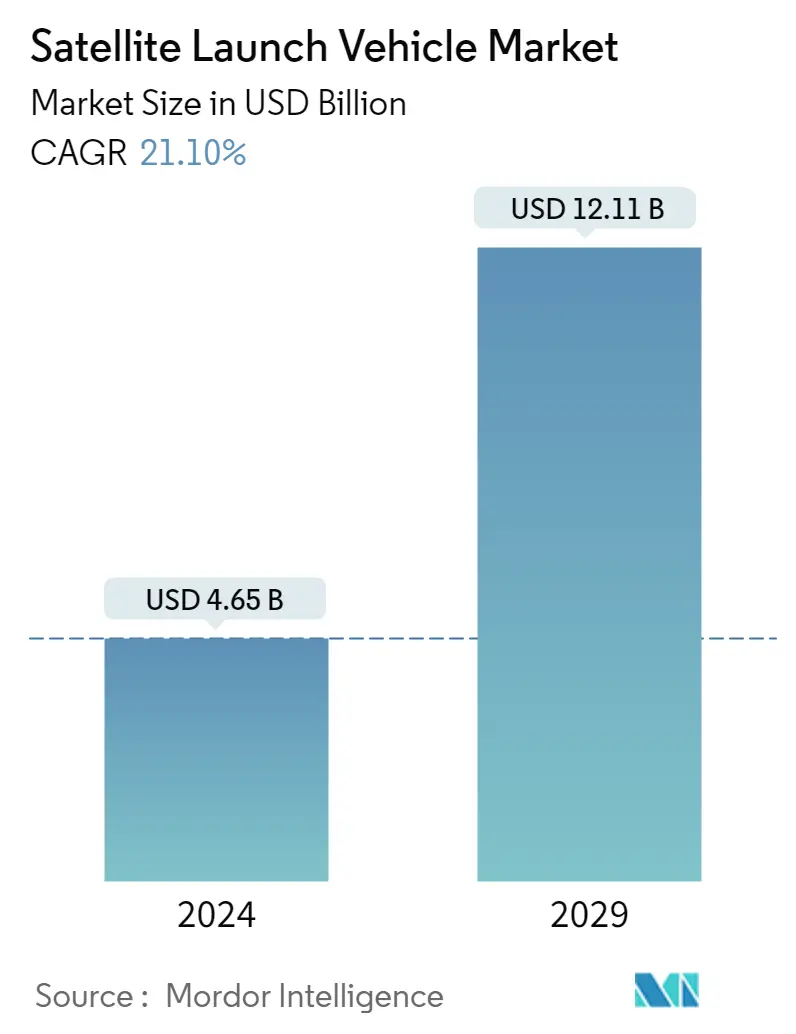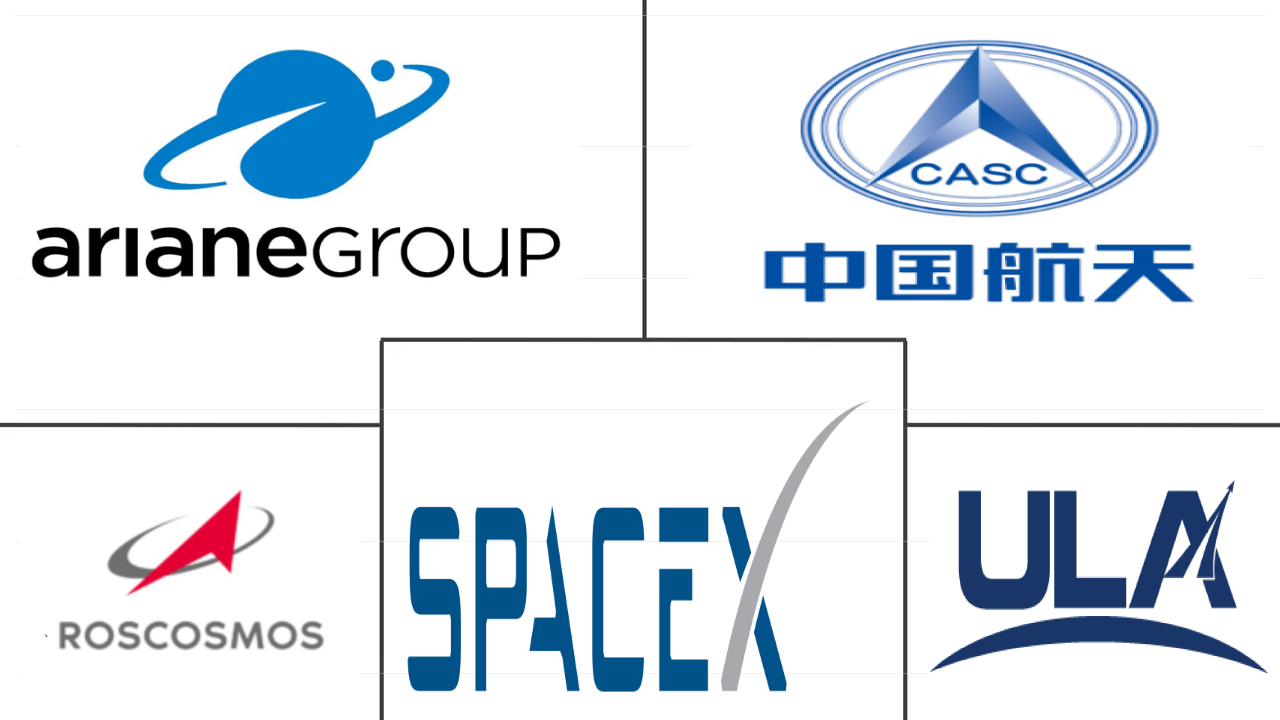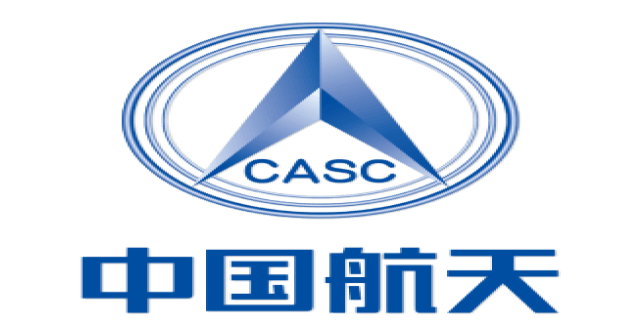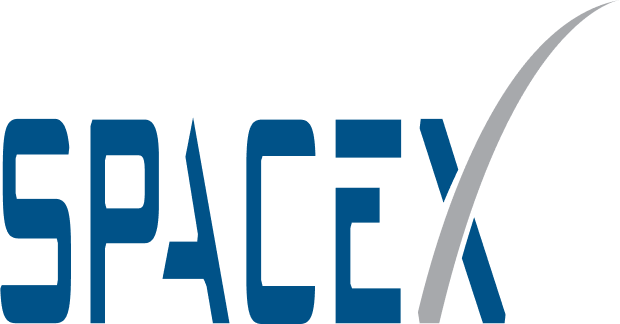Market Size of satellite launch vehicle Industry

| Icons | Lable | Value |
|---|---|---|
|
|
Study Period | 2017 - 2029 |
|
|
Market Size (2024) | USD 4.65 Billion |
|
|
Market Size (2029) | USD 12.11 Billion |
|
|
Largest Share by Orbit Class | LEO |
|
|
CAGR (2024 - 2029) | 21.10 % |
|
|
Largest Share by Region | Asia-Pacific |
|
|
Market Concentration | High |
Major Players |
||

|
||
|
*Disclaimer: Major Players sorted in no particular order |
Satellite Launch Vehicle Market Analysis
The Satellite Launch Vehicle Market size is estimated at USD 4.65 billion in 2024, and is expected to reach USD 12.11 billion by 2029, growing at a CAGR of 21.10% during the forecast period (2024-2029).
4.65 Billion
Market Size in 2024 (USD)
12.11 Billion
Market Size in 2029 (USD)
-5.22 %
CAGR (2017-2023)
21.10 %
CAGR (2024-2029)
Largest Market by Launch Vehicle MTOW
51.11 %
value share, Medium, 2022
The demand for medium launch vehicles is fueled by the granting of multi-year contracts by government and commercial end users to launch vehicle manufacturers and launch service providers.
Fastest-Growing Market by Orbit class
25 %
Projected CAGR, LEO, 2023-2029
Government initiatives pertaining to LEO satellites and their numerous uses, such as commercial communications, Earth observation, navigation, and military surveillance, will likely aid in the growth of LEO satellites.
Largest Market by Orbit Class
47.76 %
value share, LEO, 2022
LEO satellites are increasingly being adopted in modern communication technologies as they play an important role in Earth observation applications.
Leading Market Player
69.39 %
market share, China Aerospace Science and Technology Corporation (CASC), 2022

China Aerospace Science and Technology Corporation (CASC) is the largest player in the market. It offers a diverse range of launch vehicles and adopts a competitive pricing strategy to attract customers globally.
Second Leading Market Player
38.26 %
market share, Space Exploration Technologies Corp., 2022

SpaceX is the leading player in the global satellite launch vehicle market and maintains its market share globally through its Starlink project. The company produces 120 satellites per month.
The demand for LEO satellites is driving the segment's growth
- During the launch, a satellite or spacecraft is usually placed into one of many special orbits around the Earth. It can also be launched into an interplanetary journey using a launch vehicle propelled by rocket engines. Satellites orbit the Earth at varying distances depending on their design and primary purpose. Each distance has its own benefits and challenges, including increased coverage and decreased energy efficiency. Satellites in medium Earth orbit (MEO) include navigational and specialized satellites designed to monitor a specific area. Most Earth science satellites, including NASA's Earth Observation System, are in low Earth orbit (LEO).
- Different satellites manufactured and launched in these orbits have different applications. For instance, from 2017 to 2022, almost 4,131 satellites were deployed in LEO, focusing mainly on communication and Earth observation. Most of the 57 satellites launched in MEO were built for navigation/global positioning purposes. Similarly, most of the 147 satellites in GEO were deployed for communication and Earth observation purposes.
- LEO is the most commonly used orbit due to its various advantages, such as close proximity, the presence of the International Space Station (ISS), and no compulsion to follow the equator path. In this orbit, satellites travel at a speed of around 7.8 km per second and take approximately 90 minutes to circle Earth, meaning the ISS travels around Earth about 16 times a day.
- The increasing usage of satellites in areas such as electronic intelligence, Earth science, laser imaging, electronic intelligence, optical imaging, and meteorology is expected to drive the demand for launch vehicles. The market is expected to grow by 210% in 2029, outpacing the amount recorded in 2023.
Asia-Pacific and North America are expected to occupy a major cumulative share of 92% in 2029
- The space industry has seen remarkable growth in recent years, with numerous companies emerging as major players in the development and deployment of launch vehicles. North America has been a pioneer in space exploration, with many space missions having their origins in the region. SpaceX is currently the leading provider of launch services in the region, with its launch vehicles including Falcon-9, Falcon Heavy, and Starship. During 2017-2022 SpaceX's rockets launched approximately 2,744 satellites into orbit.
- In Europe, companies like ArianeGroup are developing the Ariane Next rockets, including a reusable first stage. Russia's Roscosmos is another key player in the industry, with a long history of developing and deploying launch vehicles. The company is responsible for developing the Soyuz and Proton rockets, which have been used to launch a range of satellites into space. During 2017-2022, the Soyuz rocket launched approximately 611 satellites into space for various satellite operators globally.
- In Asia-Pacific, CASC is responsible for developing and deploying a range of launch vehicles, including the Long March series, which has become one of the most reliable launch vehicles in the world. During 2017-2022, CASC's Long March rocket launched approximately 372 satellites into space for various satellite operators globally. JAXA, on the other hand, has developed H-IIA and H-IIB rockets. During 2017-2022, JAXA's H-IIA rockets launched approximately 25 satellites into space for various satellite operators globally. During 2017-2022, ISRO's rockets launched approximately 171 satellites into space for various satellite operators globally.
Satellite Launch Vehicle Industry Segmentation
GEO, LEO, MEO are covered as segments by Orbit Class. Heavy, Inter Planetary, Light, Medium are covered as segments by Launch Vehicle Mtow. Asia-Pacific, Europe, North America are covered as segments by Region.
- During the launch, a satellite or spacecraft is usually placed into one of many special orbits around the Earth. It can also be launched into an interplanetary journey using a launch vehicle propelled by rocket engines. Satellites orbit the Earth at varying distances depending on their design and primary purpose. Each distance has its own benefits and challenges, including increased coverage and decreased energy efficiency. Satellites in medium Earth orbit (MEO) include navigational and specialized satellites designed to monitor a specific area. Most Earth science satellites, including NASA's Earth Observation System, are in low Earth orbit (LEO).
- Different satellites manufactured and launched in these orbits have different applications. For instance, from 2017 to 2022, almost 4,131 satellites were deployed in LEO, focusing mainly on communication and Earth observation. Most of the 57 satellites launched in MEO were built for navigation/global positioning purposes. Similarly, most of the 147 satellites in GEO were deployed for communication and Earth observation purposes.
- LEO is the most commonly used orbit due to its various advantages, such as close proximity, the presence of the International Space Station (ISS), and no compulsion to follow the equator path. In this orbit, satellites travel at a speed of around 7.8 km per second and take approximately 90 minutes to circle Earth, meaning the ISS travels around Earth about 16 times a day.
- The increasing usage of satellites in areas such as electronic intelligence, Earth science, laser imaging, electronic intelligence, optical imaging, and meteorology is expected to drive the demand for launch vehicles. The market is expected to grow by 210% in 2029, outpacing the amount recorded in 2023.
| Orbit Class | |
| GEO | |
| LEO | |
| MEO |
| Launch Vehicle Mtow | |
| Heavy | |
| Inter Planetary | |
| Light | |
| Medium |
| Region | |||||||
| |||||||
| |||||||
| |||||||
|
Satellite Launch Vehicle Market Size Summary
The Satellite Launch Vehicle Market is poised for significant expansion, driven by the increasing demand for satellite deployment across various orbits, including Low Earth Orbit (LEO), Medium Earth Orbit (MEO), and Geostationary Orbit (GEO). The market is characterized by the deployment of satellites for diverse applications such as communication, Earth observation, navigation, and scientific research. The proliferation of satellites in LEO, in particular, is notable due to its advantages like proximity to Earth and the presence of the International Space Station. The market's growth is further fueled by advancements in launch vehicle technology and the rising number of space missions globally, with key players in North America, Europe, and Asia-Pacific leading the charge.
The competitive landscape of the Satellite Launch Vehicle Market is dominated by major companies such as SpaceX, ArianeGroup, ROSCOSMOS, and China Aerospace Science and Technology Corporation (CASC), among others. These companies are at the forefront of developing and deploying advanced launch vehicles, including reusable rockets, to meet the growing demand for satellite launches. Government investments in space programs, particularly in North America and Europe, play a crucial role in supporting the industry's growth. The market is expected to experience robust growth, with significant contributions from both established players and emerging companies, as they strive to enhance their capabilities and expand their market share in the evolving space industry.
Satellite Launch Vehicle Market Size - Table of Contents
-
1. MARKET SEGMENTATION (includes market size in Value in USD, Forecasts up to 2029 and analysis of growth prospects)
-
1.1 Orbit Class
-
1.1.1 GEO
-
1.1.2 LEO
-
1.1.3 MEO
-
-
1.2 Launch Vehicle Mtow
-
1.2.1 Heavy
-
1.2.2 Inter Planetary
-
1.2.3 Light
-
1.2.4 Medium
-
-
1.3 Region
-
1.3.1 Asia-Pacific
-
1.3.1.1 By Country
-
1.3.1.1.1 China
-
1.3.1.1.2 India
-
1.3.1.1.3 New Zealand
-
-
-
1.3.2 Europe
-
1.3.2.1 By Country
-
1.3.2.1.1 Russia
-
-
-
1.3.3 North America
-
1.3.3.1 By Country
-
1.3.3.1.1 United States
-
-
-
1.3.4 Rest of World
-
1.3.4.1 By Country
-
1.3.4.1.1 Iran
-
1.3.4.1.2 Rest of World
-
-
-
-
Satellite Launch Vehicle Market Size FAQs
How big is the Satellite Launch Vehicle Market?
The Satellite Launch Vehicle Market size is expected to reach USD 4.65 billion in 2024 and grow at a CAGR of 21.10% to reach USD 12.11 billion by 2029.
What is the current Satellite Launch Vehicle Market size?
In 2024, the Satellite Launch Vehicle Market size is expected to reach USD 4.65 billion.

